Indian Rupee is the national currency of India.
There are some facts about Indian currency that many of us do not know. So I am here to tell you some facts about the Indian currency like the History of Indian currency, Coin history in India, Indian Currency Symbol, mint of the coin in India, Indian Currency Printing Press, Images on Indian Currency, and Languages on Indian Currency Notes.
So let’s start first with the History of Indian Currency.
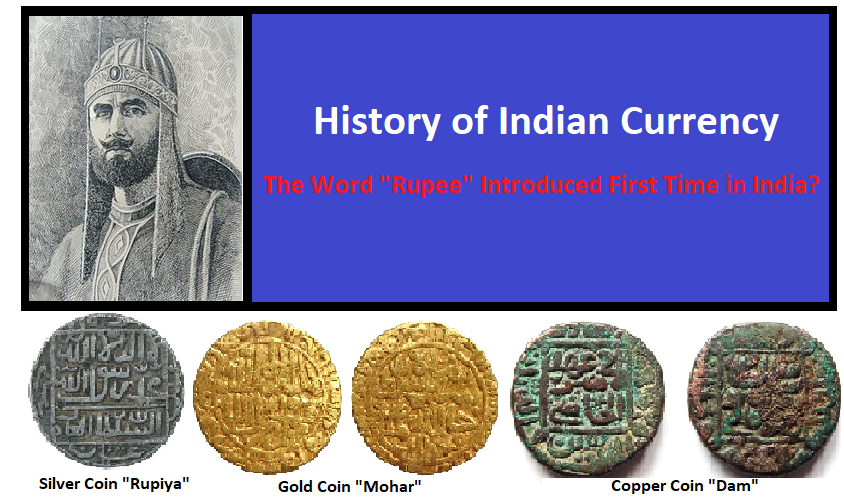
The word “rupee” is derived from the Sanskrit word “rupyakam” which means silver coin.
The word “rupee” was first used by Sher Shah Suri in India during 1560–1585. Sher Shah Suri issued silver, gold and copper coins as currency which are called “Rupya”, “Dam” and “Mohar'' respectively. And it remained in circulation in India during Mughal and the British period.
The word 'Rupee', which was started during the reign of Sher Shah Suri, is also in use today.
When European trading companies came to India in the 18th century, they introduced paper currency in India to facilitate their business.
The Bank of Hindustan, General Bank in Bengal and the Bengal Bank became the first banks in India to issue paper currency In the 18th Century. The printing of paper currency was only started after the Paper Currency Act of 1861, After this act, the government of India was given the monopoly to print Indian currency.

The first set of notes issued by British India was the 'Victoria Portrait' series in denominations of Rs 10, 20, 50, 100, 1000.
Rs 10 note in 1864, Rs 5 note in 1872, Rs 10,000 note in 1899, Rs 100 note in 1900, Rs 50 note in 1905, Rs 500 note in 1907 and Rs 1,000 note in 1909.
Due to some cases of forgeries, the 'Victoria Portrait series' was withdrawn in 1867 and replaced by the ‘Underprint Series’.
On the demand of the public, notes in the denominations of 5 rupees, 50 rupees, and 500 rupees were issued.
During the First World War, the paper currency of small denominations was issued.
On November 30, 1917, a note of 1 rupee was introduced, followed by a note of 2 rupees and 8 annas. These notes had the portrait of 'King George V'.
In 1926, because of cost benefits consideration, the issuance of these notes was discontinued.

In May 1923, a series of notes of denomination of Rs.10 were issued, bearing the portrait of King George V.
After this, there was a king’s portrait in all the currency issued in British India.
| The first currency printing press was established in 1928 in Nashik, Maharashtra. Before the establishment of the printing press in India, all the currencies of India were printed in London. |
The Indian currency was printed by the Government of India until the RBI was established in 1935.
The coin history of India started in the 6th Century. After this many emperors used coins as currency. Many rulers introduced coins of silver, gold, brass, copper etc. And these coins had portraits of the rulers of that time. The word rupee was first used for the silver coin which was introduced during the reign of Sher Shah Suri.
The paper currency started in India during British rule, but the circulation of coins continued as the Indian Currency.
A uniform coinage system was introduced in India by the British in 1835, with the name of the East India Company bearing the portrait of 'William III'. In 1840, the image was replaced by the image of 'Queen Victoria', but the design remained the same.
Significant changes were made in the next set of coins which was minted in 1862. The name “East India Company” was replaced by “India”. The portrait of 'Queen Victoria' was also changed, which was depicted in a royal robe with a crown.
After independence in 1947, India retained the previous imperial currency with images of British monarchs.
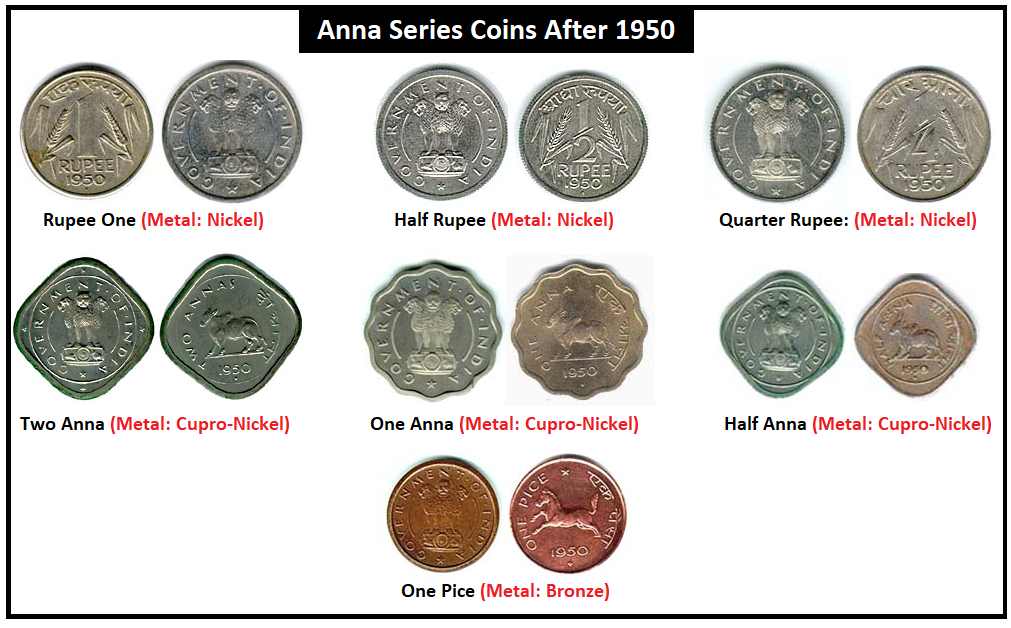
In 1950 the new series was introduced and the British monarch's portrait was replaced by the 'Lion Capital of Ashoka Pillar'.
Until 1957 the monetary system remained unchanged with one Rupee consisting of '16 Annas'.
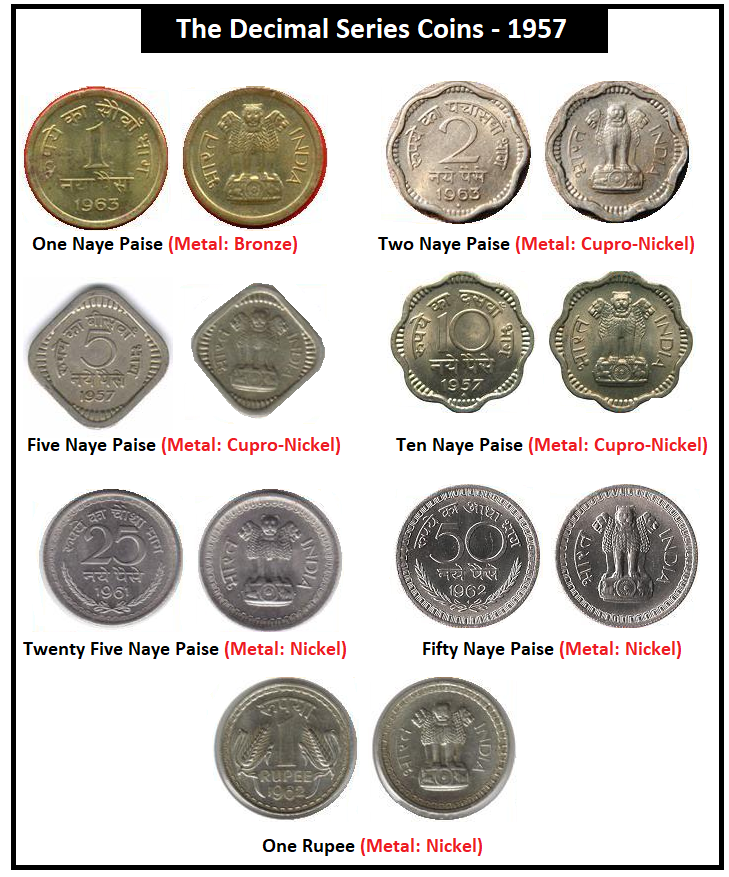
In 1957, the new decimal series was introduced and 1 rupee was divided into 100 “Naye Paise” (previously divided into 16 Annas or 64 Pice).
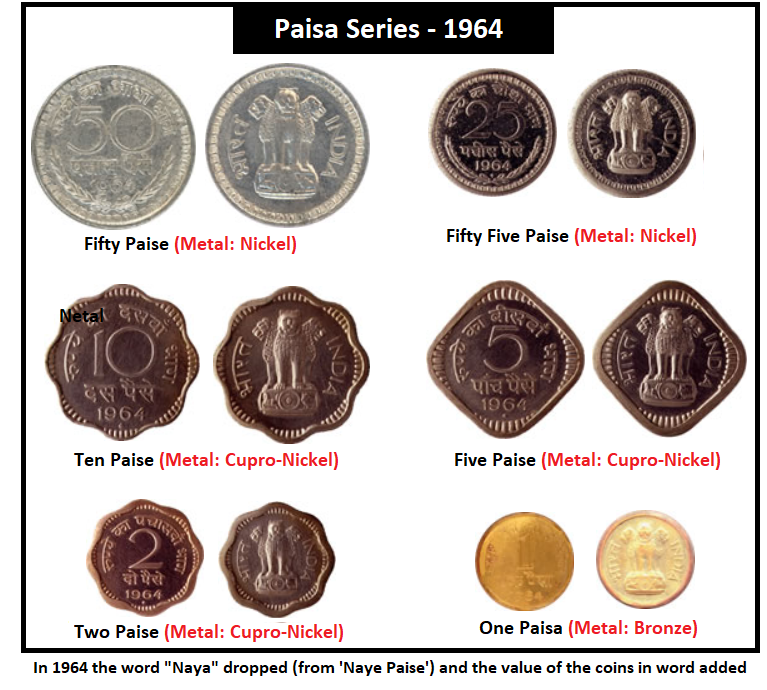
In 1964 the word “Naye" was dropped and the value of the coin in the word was added in place of it.
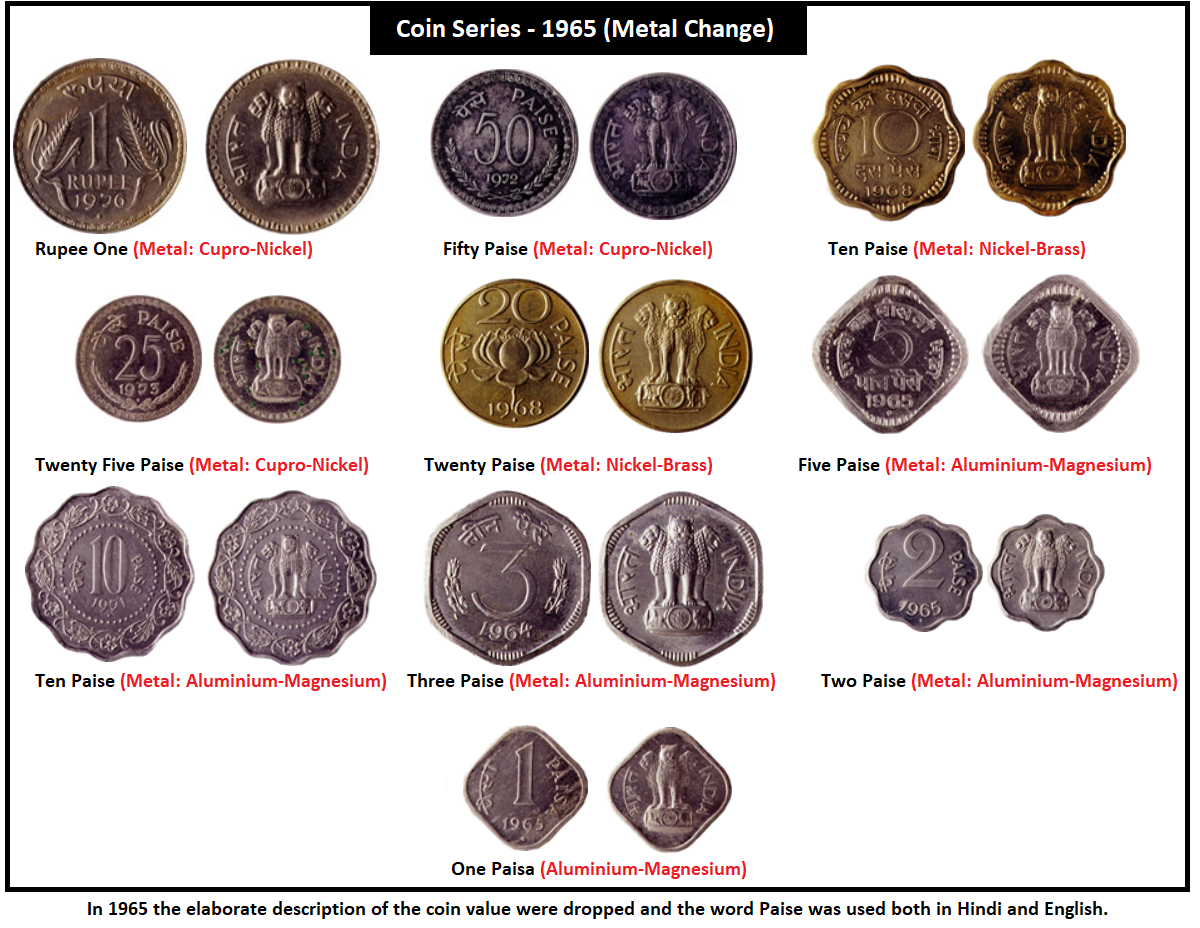
In 1965, the word "paise" was written in both Hindi and English in place of elaborate descriptions.
Because of cost-benefit considerations 1, 2, and 3 paise coins were discontinued in the seventies.
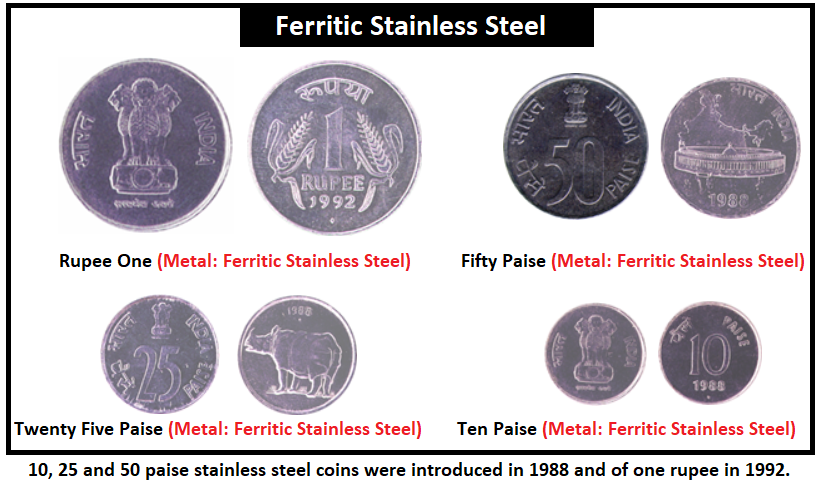
10, 25, and 50 paise coins of stainless steel were introduced in 1988 and 1 rupee coins were introduced in 1992. New designs depicting rhinoceros at 25 paise, and Indian Parliament on the map of India at 50 paise, were introduced in ferritic stainless steel coins.

A 2 rupee coin was introduced in 1982. It was introduced depicting the map of India with the national flag explaining national unity. A 5 rupee cupro-nickel coin was introduced in 1992 to supplement the paper currency. A 5 rupee coin was introduced depicting the lotus buds and flower with leaves and stem.
In 2003, because of low demands of lower denominations coins, it was decided to phase out from circulation all lower denomination coins such as 5 paise, 10 paise and 20 paise and cupro-nickel coins of 25 paise, 50 paise and one rupee.
The 20 paise coin was discontinued in 1997, followed by the 10 paise coin in 1998 and the 25 paise coin in 2002.
Due to rising metal prices, cupro-nickel coins of 2 rupee were discontinued. And in 2006, it was decided to mint all denomination coins in ferritic stainless steel.
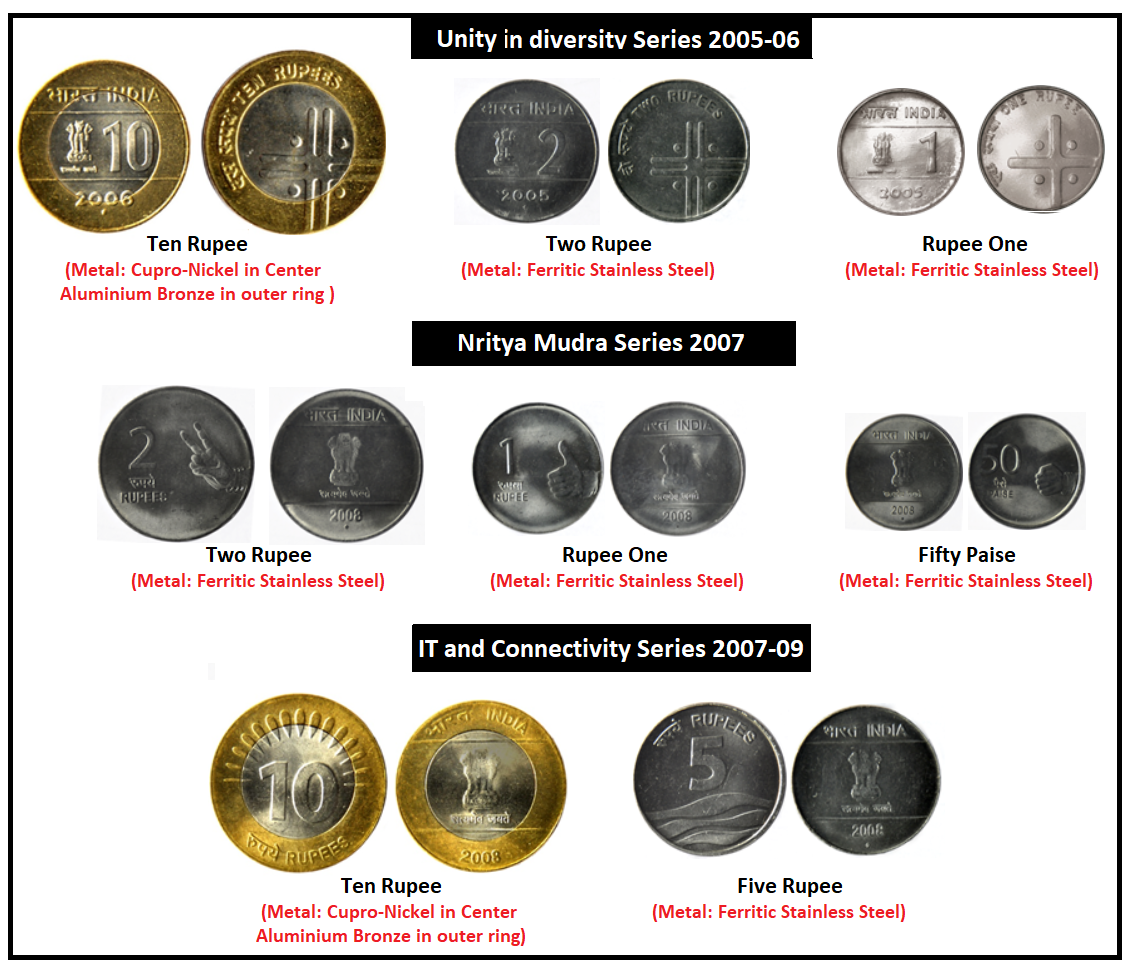
A new series namely “Unity in Diversity” was introduced in 2005. In the coins of the denominations of Rs. 1, Rs. 5 and Rs. 10, "Unity in Diversity" is presented by intersecting lines with four dots.
In 2007, a new series namely “Nritya Mudra” was introduced. This series was started for ferritic stainless steel coins of denomination of 50 paise, Rs.1, and Rs. 2. The sign used in 50 paise was “Clenched Fist”, on Rs. 1 was “Thumbs Up” and on Rs. 2 was “Two Fingers”.
In 2007, a new Rs 5 Ferritic Stainless Steel coin was issued, depicting the design of the sea waves.
In 2008, a new Rs 10 coin was issued with 15 rays connecting inner and outer circles.
In 2009, Rs. 5 Metal was Changed into Nickel Brass. This Rs 5 coin had the picture of Lotus as before.
In exercise of the powers conferred by section 15A of the Act, 1906, circulation of coins of denomination of 25 paise and below was called off by the government of India in 2011.
| According to the Coinage Act, 1906, coins up to 1000 rupees can be issued. |
On 1 April 1935, the Reserve Bank of India was established in Kolkata and was empowered to print and issue the Indian Currency. The Reserve Bank of India reserves the right to print all types of notes except a 1 rupee note.
The government of India has the right to mint coins and ₹ 1 note.
All types of notes except the 1 rupee note are signed by the Governor of the Reserve Bank of India.
All types of coins and notes are issued for circulation only through the Reserve Bank in terms of the RBI Act.
The first paper currency issued by RBI in 1938, was a 5 rupee note and it had the portrait of 'King George VI’s'.
After this RBI also issued Rs. 2, 10, 50, 100, 1,000 and 10,000 notes in the same year.
| The first governor of the RBI was Sir Osborne Smith. He did not sign any banknote issued by the RBI. The second governor of RBI Sir James Taylor signed all the banknotes issued by the RBI. |
The government of India continued issuing Rs 1 note.
In August 1940, during the Second World War, 1 rupee note was reintroduced. After this, a 2 rupee note was also issued on 3 March 1943 (instead of 2 rupees 8 annas).
In 1946 the 1000 rupee and 10,000 rupees were stopped to be printed. But in 1954, the printing of 1000 and 10000 rupee notes started again with the 5000 rupee notes.
The RBI began printing notes with a security thread and new watermarks in 1944.
The George VI series continued till 1947. On 15 August 1947, India got freedom. And the first banknote printed in India after independence (1950) was the 1 rupee note. It had the picture of Ashoka’s Pillar.
The 10 rupee banknote with 'Lion Capital Series' was issued by the RBI in 1970. It had the picture of 'Ashoka Pillar'.
The 50 rupee banknote with the 'Lion Capital Series' was first introduced by RBI in 1975. It had the picture of 'Ashoka Pillar'.
The second note-printing press was established in Dewas, Madhya Pradesh in 1975, the third in Mysore in 1999 and the fourth in Salboni, West Bengal in 2000.
Note: In 1953, Hindi was prominently displayed on new notes.
Note: In 1978, the Janata Party government issued an ordinance withdrawing Rs 1000, 5000 and 10000 notes.
Rs 500 was introduced in 1987 with the portrait of Mahatma Gandhi. Rs 1 and Rs 2 notes were discontinued in 1995.
On 9 October 2000, Rs. 1000 notes were issued for the second time with Mahatma Gandhi's Series. On November 18, 2000, Rs. 500 denomination note was issued with the Mahatma Gandhi series.
The printing of Rs. 5 notes, which had previously been discontinued, restarted in 2009.
On 8 November 2016, Rs. 1000 notes were completely discontinued.
The "Year of printing" on the banknotes was introduced for the first time in 2005.
₹ 1 note was reintroduced by the government of India in 2015.
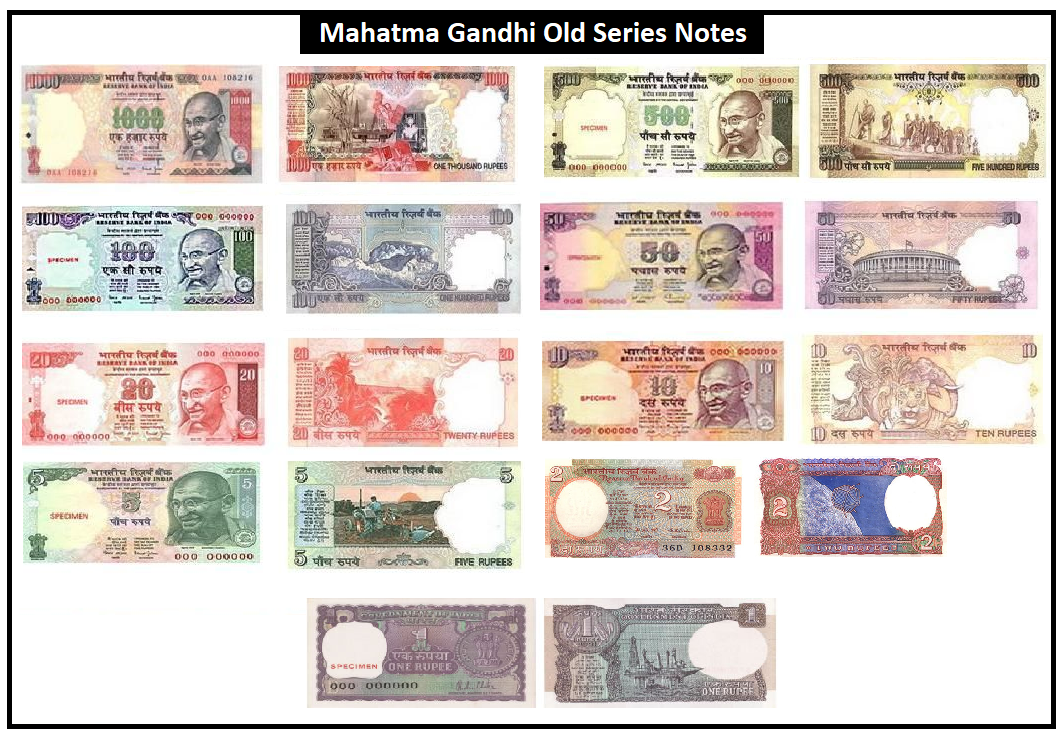
In 1969 a commemorative design series of 1 rupee notes were issued by RBI in honour of the birth centenary celebrations of Mahatma Gandhi, showing him seated in the backdrop of the Sevagram Ashram.
In 1987 a new series of 500 rupee notes were introduced with the portrait of Mahatma Gandhi.
After this many changes were made in the format of Indian Currency.
Before the introduction of the Mahatma Gandhi series of banknotes, various symbols of national and religious significance were printed on the Indian currency.
Some images that were printed in notes are Konark temple of Orissa on Rs. 20, Brihadeeswara temple on Rs. 1000 and Gateway of India on Rs. 5000. Apart from this, there were pictures of Ashoka’s Pillar on many banknotes.
But in 1996 a new series with Gandhi’s portrait was issued and it replaced all the banknotes that were printed till then. The Reserve Bank of India (RBI) issued the series in 1996 with banknotes of 10 and 500 rupees.
All the notes printed after 1996, all had Gandhi's portrait printed on them.
The Ashoka Pillar has not been removed, rather it is still printed on the notes.
The picture of Gandhi Ji which was printed on notes was taken in 1946 by an unknown photographer during the meeting of Gandhi Ji with Lord Frederick William Pethick-Lawrence in the viceroy house (presently known as Rashtrapati Bhavan).
Rs. 20 notes in the Mahatma Gandhi series were introduced in August 2001 by RBI.

Demonetisation of ₹ 500 and ₹ 1000 notes was done on 8 November 2016.
The new Gandhi’s series was released with the denomination of ₹ 500 and ₹ 2000 notes on 10 November 2016.
In the new Gandhi series, the Swachh Bharat logo is also provided on the backside in the banknote.
In January 2018, a new ₹ 10 banknote with Mahatma Gandhi new series was introduced by RBI.
₹ 20 new banknotes with Mahatma Gandhi new series was introduced in 2019 by the RBI.
₹50 banknotes with the Mahatma Gandhi new series was introduced on 18 August 2017 by RBI.
₹100 banknotes with the new Mahatma Gandhi series was introduced on 19 July 2018 by RBI.
₹ 200 banknotes with the new Mahatma Gandhi series was introduced on 23 August 2017 by RBI.
The image on ₹ 5 note
There is a “Progress Farm Mechanisation” image on ₹ 5 note.
The image on ₹ 10 note
There is a “Konark Sun Temple wheel'' image on the ₹ 10 note of Mahatma Gandhi New Series. The ₹ 10 notes of the Mahatma Gandhi series bear the image of the fauna of India - rhinoceros, elephant and tiger. Which is still in existence.
The image on ₹ 20 note
There is an image of “Ellora Caves” on the ₹ 20 note of Mahatma Gandhi New Series. In the Mahatma Gandhi Series of ₹ 20 note, there is the view of "Mount Harriet LightHouse" in Port Blair. The Mahatma Gandhi Series of ₹ 20 notes is still in existence.
The image on ₹ 50 note
There is an image of the “Chariot of Hampi (Karnataka)” on the New Mahatma Gandhi Series of ₹ 50 note. In the Mahatma Gandhi Series of ₹ 50 note, there is an image of “Indian Parliament”. It is still in existence.
The image on ₹ 100 note
There is an image of “Rani ki Vav'' on the New Mahatma Gandhi Series of ₹100 note.
In the Mahatma Gandhi Series of ₹100 note, there is an image of "Mount Kanchenjunga”. It is also in existence.
The image on ₹ 200 note
There is an image of “Sanchi Stupa” in the ₹200 note. ₹ 200 note issued in India for the first time after demonetization.
The image on ₹ 500 note
There is an image of “Red Fort” on the New Mahatma Gandhi Series of ₹ 500 note. Previously there was an image of “Gandhi’s Dandi March” on the old Mahatma Gandhi Series. This note of ₹ 500 is not in circulation after demonetization.
The image on ₹ 2000 note
There is an image of “Mangalyaan” on the New Mahatma Gandhi Series of ₹ 2000 note. ₹ 2000 note issued in India for the first time after demonetization.
Note: There is a “Swachh Bharat Logo” with a Slogan on the backside of the New Mahatma Gandhi Series notes.
As per the Coinage Act,1906, the government of India has the right to mint coins and 1 rupee note.
But according to the RBI Act, the coins are issued and circulated only through the Reserve Bank of India.
There are four mints in India to mint the coins. These are located in Mumbai, Kolkata (Alipore), Hyderabad (Saifabad, Cherlapally), and Noida. From the mark given below the year of casting coins, you can find out at which place the coins have been minted.
If there is a star mark given below the year, this means this coin is minted in Hyderabad. If there is a Solid dot mark given below the year, this means this coin is minted in Noida. If there is a Diamond mark given below the year, this means this coin is minted in Mumbai. If there is no mark given below the year, it means the coin is minted in Kolkata.
The mint of Mumbai was the first mint in India. It was established in 1829, while Hyderabad was established in 1903 (Saifabad) and 1997 (Cherlapally) and Kolkata in 1952. Noida is the latest mint, founded in the year 1988.
Note: Noida's mint was the first mint in the country to mint stainless steel coins.
The first Indian commemorative coin was issued in 1964 to commemorate the birth anniversary of Jawaharlal Nehru.
₹75, ₹150, and ₹1000 coins were minted in India In the years 2010 and 2011 for the first time ever. ₹75 coins to commemorate the Platinum Jubilee of the RBI, the coin of ₹150 to celebrate the 150th birth anniversary of Rabindranath Tagore, and ₹ 1000 coins to celebrate 1000 years of Brihadeeswarar Temple.
In 2012 a coin of ₹ 60 was also issued to commemorate 60 years of the Government of India Mint, Kolkata.
On 4 September 2015 and 6 December 2015, the commemorative coins of ₹125 were released to honour the 125th anniversary of the births of Sarvepalli Radhakrishnan and B. R. Ambedkar, respectively.
There are four Indian Currency printing presses in India. Two of these printing presses are owned by the Government of India and two are owned by the Reserve Bank of India.
The printing presses owned by the government of India are Indian Security Press, Nasik (Maharashtra) and Bank Note Press, Dewas (Madhya Pradesh). More than 40% of Currency Notes circulated in India are printed by these two units.
Two other printing presses owned by the Reserve bank of India are at Mysore (Karnataka) and Salboni (West Bengal).
Indian Security Press, Nasik, Maharashtra
Indian security Press was started in 1928 for printing Indian currency. It is the oldest printing press in India, established in 1926. Indian Security Press prints Indian currency notes of Rs. 10, 20, 50, 100, 500, and 2000. It also prints postal stamps, checks of banks, national savings letters, passports, Indira Vikas Patra, postal order, Kisan Vikas Patra etc.
Bank Note Press, Dewas, Madhya Pradesh
It is the second Note press in India, started in 1975. It prints 10, 50, 100, 500 and 2000 banknotes and also has an ink factory that manufactures inks for securities papers.
Mysore and Salboni
Mysore bank note press is located in Karnataka, which started in 1999 and the Salboni banknote press is located in West Bengal, which started in 2000. These two printing presses work under RBI control.
Security Printing Press, Hyderabad
It was established in 1982. It was established to fulfil the demand of the Central Excise Stamp of the country. It was established to supplement the production of Indian Security Press Nashik Road Maharashtra.
Security Paper Mill, Hoshangabad, Madhya Pradesh
Security Paper Mill Hoshangabad was started In 1968, and it started for the production of printing Indian currency notes and stamp paper. Currency notepaper and non-judicial stamp paper are printed in this security Papermill. However, most of the paper in India's notes is imported from Germany, Japan and the UK.
|
You will not believe that before Independence, the value of ₹ 1 was equal to $13 dollar. But after independence, the value of ₹ 1 became equal to $ 1. After independence, the value of the rupee kept falling continuously.
Currently, the value of $1 Dollar has become equal to ₹ 74.
After independence, the Indian currency was devalued three times in India. The first time in 1949, the second time in 1966 and the third time in 1991.
When the currency was first devalued in 1949, then the value of $1 became equal to Rs 4.75. The second time when the currency was devalued was in 1966 when the value of $1 became equal to Rs 7.
In 1991, when the currency was devalued for the third time, the value of $1 became equal to Rs 17.
|
|
To select the symbol of the Indian currency, the Government had organized a national competition in which the government received more than 3000 applications.
An official symbol for Indian currency was chosen on 15 July 2010 which was designed by Professor D. Udaya Kumar of IIT, Guwahati.
The Indian currency has become the fifth currency to be identified by its symbol after the US Dollar, British Pound, Japanese Yen and European Union Euro.
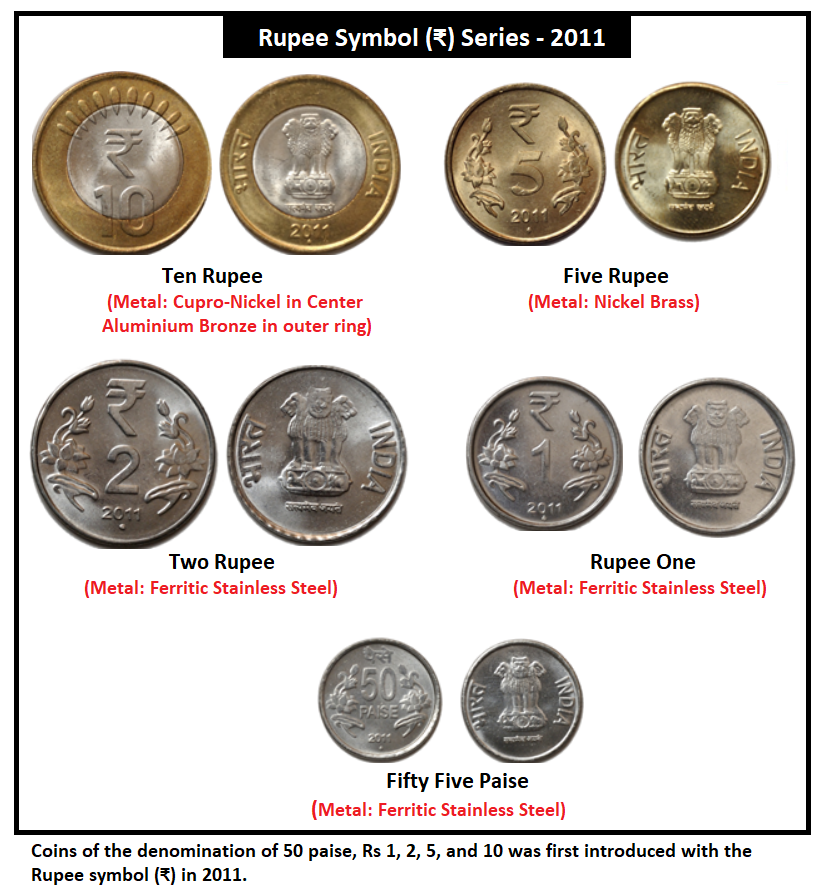
The rupee symbol (₹) was depicted above the numeric value of the coin. The 10 rupee coin now has 10 rays instead of 15, above the rupee symbol (₹).
Coins of 50 paise, ₹ 1, ₹ 2, and ₹ 5 denominations depict the lotus bud and flower with stem and leaves on both sides of the numerical value.
| Indian Currency Code is INR (Indian Rupee). |
|
There are 17 languages printed on Indian currency, out of which 15 languages are printed on the backside and 2 languages, Hindi and English in front.
All 17 languages printed on Indian currency are official languages of India.
The languages, printed on the backside of Indian Currency are:
There are 2 languages printed on the front of the Indian Currency note -
The denomination of the notes is written in Hindi and English languages.